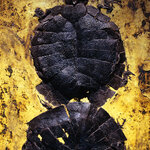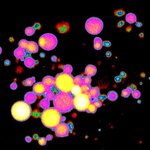Evolution

Part of the enjoyment of doing research is that ideas pop into your head all the time. Everyone has ideas, but the hard part is to choose which should be subjected to critical tests that have the primary aim of proving them wrong. That’s the most efficient way to discard bad ideas, because most of them in fact don’t work. Only after an idea survives the crucible of initial testing can it be taken more seriously and tested further. Then, if it still survives, you can publish.
Last week I described the rationale underlying a hypothesis…

Rearrangements in genomes, genes and exons can result from a glitch in DNA copying that occurs when the process stalls at a critical point and then shifts to a different genetic template, duplicating and even triplicating genes or just shuffling or deleting part of the code within them, said researchers from Baylor College of Medicine in a recent report in Nature Genetics. The report further elucidated the effect of the fork stalling and template switching mechanism involved in some forms of copy number variation.
The mechanism not only represents a newly discovered method by which the genome…

A new journal is out - Genome Biology and Evolution. To my surprise, it actually looks quite good, with high-quality pieces. I generally don't see many new journals I like, but this one fills a needed niche. A lot of genome papers bear on evolution, but the authors aren't really evolutionary biologists; many evolutionary biologists don't have a lot of contact with hard-core genomics. But there is a growing community of researchers who function well in both worlds, and this journal fits that community.
As the editors say:
About 50 years ago, the field of molecular evolution emerged at the…

it is PURPOSEdat driveUS !evolution has succeded, we are more intelligent, smart, beautiful, sexy than ever, but one has2WonDRwattis DA purpose ? is thereAPurPOse ??? X-or no ?anyWeiZ, watICANsei4SUre isdat dere isno evolutionary limit, there is NO BOUND, no threshold, no LIMIT...nonononononono dereisNOLIMITs!!!fromWATIrealiSD, someparTofDAG-nomeTOMMYHaS2con-V-erGD&&dcleba2mer2[is]. w2enTingAG!aNEWRst

More incredible finds from the Messel Pit:
"These 49 million-year-old freshwater turtle fossils are believed to have died of poisoning during copulation."
(Photograph: Jonathan Blair/Corbis, published at The Guardian Online.)

I have a hard time believing this is for real:
Researchers from the University of Pittsburgh and the Buffalo Museum of Science say we've been making a mistake using DNA to contend that humans are most closely related to chimpanzees. The fossil record says otherwise, they report in the Journal of Biogeography.
Jeffrey H. Schwartz, professor of anthropology in Pitt's School of Arts and Sciences and president of the World Academy of Art and Science, and John Grehan, director of science at the Buffalo Museum, conducted an analysis of the physical features of living and…

Researchers from the University of Pittsburgh and the Buffalo Museum of Science say we've been making a mistake using DNA to contend that humans are most closely related to chimpanzees. The fossil record says otherwise, they report in the Journal of Biogeography.
Jeffrey H. Schwartz, professor of anthropology in Pitt's School of Arts and Sciences and president of the World Academy of Art and Science, and John Grehan, director of science at the Buffalo Museum, conducted an analysis of the physical features of living and fossil apes that suggested humans, orangutans, and early…

There must have been an abundant source of free energy on the early Earth that could produce the polymers required for natural experiments leading to the origin of life. What was it? Last week I described how protein-like polymers can be synthesized simply by drying and heating amino acids, but I also noted that most of the chemical bonds produced by this “shake and bake” approach have nothing to do with biology. On the other hand, there is no doubt that the energy available in heating and drying can drive polymerization reactions. If there is a way to organize monomers so that they undergo…

Now online, PNAS has a special evolution issue, based on a talks given at a conference, with pieces by Daniel Dennett, Francisco J. Ayala, Michael Ruse, Elliot Sober, and more. Some of the titles:
"Darwin and the scientific method"
"Natural selection in action during speciation"
"Human-induced evolution caused by unnatural selection through harvest of wild animals"
"Darwin's “strange inversion of reasoning”"
And don't miss this one:
"Postcopulatory sexual selection"

Almost 140 years ago, Charles Darwin formalized what many people already believed - mate selection isn't pure chance; it's a deliberate process that involves numerous factors, including biological ones.
Darwin scored a scientific bullseye but a very big question has been, "What have we learned since then?"
Adam Jones, a Texas A&M University evolutionary biologist, says that Darwin's beliefs about the choice of mates and sexual selection being beyond mere chance have been proven correct, as stated in Darwin's landmark book "The Descent of Man, and Selection in Relation to Sex"…